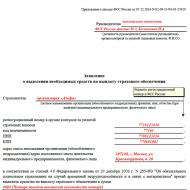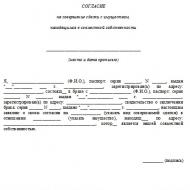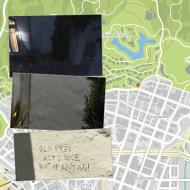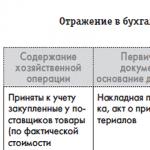
How to tell if soil is heaving or not. Is the loam heaving or not? Methods to combat bloating
Any construction begins with a soil study. In an already built-up area, you can skip this stage and use the results of studies carried out for other buildings. But often the development of a site begins with a garage. Good example– a frame garage-house, which was built by us as a warehouse for building materials and temporary housing for builders.
You need to have a good idea of what kind of soil you are building a garage on. Based on its properties, the type is selected and the foundation parameters are calculated. An improperly designed foundation can, at best, cost more than necessary, and at worst, fail.
Soil heaving is one of the most serious dangers that await foundations built without proper research. However, you should also not forget about incorrect shrinkage.
Table for determining the degree of soil heaving. Z – a value indicating how many meters the groundwater level is below the freezing depth
If you do not want to use the services of specialists, first you will have to dig a hole two meters deep with neat vertical walls at the site of the future construction. This way you can visually determine the type of soil. Also, you can do a simple experiment that will help clear your doubts if you have any.
Take a handful of soil and add water to it. Roll up the “sausage” and, attention, the most crucial moment, roll it into a bagel. Depending on what happened to the “sausage”, we draw conclusions:
- It turned out to be an excellent bagel - this is clay;
- The “sausage” fell apart into several parts – loam;
- The “sausage” crumbled into small pieces – sandy loam;
- It wasn’t even possible to make the “sausage” – sand.
If it’s autumn, you can determine the groundwater level along with the type of soil. The worst thing is if water appears at the bottom of the hole. If it’s dry, it’s best to use a hand drill and increase the depth of your knowledge about the groundwater level by another meter and a half to two. The water is not visible - the groundwater is far enough away and you can even make a basement or cellar.

But we are not interested in the absolute value of the groundwater level, but in how much below the freezing depth it is. The freezing depth is a standard value and is determined from the table. It’s worth considering that winters have recently become milder than before, but every few years the winters are more severe. So if you include an additional reserve in your calculations, you won’t be mistaken.
Foundation shrinkage
Now you have all the necessary data to choose the type and depth of the foundation. All that remains is to calculate its width. Here you need to focus on the bearing capacity of the soil. If the foundation can be affected by horizontal heaving forces, the width and design of the foundation must also be taken into account, but here you can’t tell us about the calculation in a nutshell.

If the building is frame, for example, a garage made of sandwich panels, then the load on the foundation is minimal and a powerful structure is not required. The question of how best to make a foundation comes down rather to choosing the type of foundation.
But heavy capital buildings require a serious approach to the calculation of the foundation, since the load on the ground here may already be quite comparable to the maximum permissible.
Heaving phenomena- processes that occur in wet clayey, fine sandy and dusty soils during their seasonal freezing (heaving soils).
Heaving phenomena are not only large deformations of the soil, but also enormous forces - tens of tons, which can lead to great destruction.
The difficulty in assessing the impact of heaving soil phenomena on buildings lies in some of their unpredictability, due to the simultaneous impact of several processes. To better understand this, it is necessary to understand some of the processes involved in this phenomenon.
Frost heaving is due to the fact that during the freezing process, wet soil increases in volume.
This happens because water increases in volume by 12% when it freezes (which is why ice floats on water). Therefore, the more water in the soil, the more heaving it is. Thus, the forest near Moscow, standing on very heaving soils, rises in winter by 5...10 cm relative to its summer level. Outwardly it is invisible. But if a pile is driven more than 3 m into the ground, then the rise of the soil in winter can be tracked by the marks made on this pile. The rise of soil in the forest could be 1.5 times greater if there were no snow cover to cover the soil from freezing.
Degree of soil heaving
Soils according to the degree of heaving are divided into:
- highly heaving - heaving 12%;
- medium heaving - heaving 8%;
- slightly heaving - heaving 4%.
With a freezing depth of 1.5 m, the rise of highly heaving soil can be 18 cm.
The heaving of soil is determined by its composition, porosity, and groundwater level (GWL). Likewise, clayey soils, fine and silty sands are classified as heaving soils, and coarse-grained sandy and gravel soils are classified as non-heaving soils.
What does this mean:
Firstly.
In clays or fine sands, moisture, like a blotter, rises quite high from the groundwater level due to the capillary effect and is well retained in such soil. Here wetting forces between water and the surface of dust particles appear. In coarse-grained sands, moisture does not rise, and the soil becomes wet only according to the groundwater level. That is, the thinner the soil structure, the higher the moisture rises, the more logical it is to classify it as more heaving soil.
The water rise can reach:
- 4…5 m in loams;
- 1...1.5 m in sandy loam;
- 0.5...1 m in dusty sands.
In this regard, the degree of soil heaving depends both on its grain composition and on the level of groundwater or flood waters.
Slightly heaving soil - when the groundwater level is located below the calculated freezing depth:
- at 0.5 m - in dusty sands;
- at 1 m - in sandy loam;
- at 1.5 m - in loams;
- at 2 m - in clays.
Medium heaving soil - when the groundwater level is located below the calculated freezing depth:
- by 0.5 m - in sandy loam;
- at 1 m - in loams;
- by 1.5 m - in clays.
Strongly heaving soil - when the groundwater level is located below the calculated freezing depth:
- by 0.3 m - in sandy loam;
- by 0.7 m - in loams;
- by 1.0 m - in clays.
Excessively heaving soil - if the groundwater level is higher than for highly heaving soils.
Please note that mixtures of coarse sand or gravel with silty sand or clay will fully apply to heaving soils. If the coarse soil contains more than 30% of the silty-clayey component, the soil will also be classified as heaving.
Automation and comfort in the home - a series of articles and videos: PLC, PLC application, dry contact, radio channel switches, programming in CoDeSys and much more.
Secondly.
The process of soil freezing occurs from top to bottom, with the boundary between wet and frozen soil falling at a certain speed, determined mainly by weather conditions. Moisture, turning into ice, increases in volume, displacing itself into the lower layers of the soil, through its structure. The heaving of the soil is also determined by whether the moisture squeezed out from above will have time to seep through the soil structure or not, and whether the degree of soil filtration is sufficient for this process to take place with or without heaving. If coarse sand does not create any resistance to moisture and it flows away without hindrance, then such soil does not expand when frozen (Fig. 1).

As for clay, moisture does not have time to escape through it, and such soil becomes heaving. By the way, soil made of coarse sand, placed in a closed volume, which may be a well in clay, will behave like heaving (Fig. 2).

That is why the trench under shallow foundations is filled with coarse-grained sand, which makes it possible to equalize the degree of humidity along its entire perimeter and smooth out the unevenness of heaving phenomena. The trench with sand, if possible, should be connected to a drainage system that drains the perched water from under the foundation.
Third.
The presence of pressure from the weight of the structure also affects the manifestation of heaving phenomena. If the soil layer under the base of the foundation is strongly compacted, then the degree of heaving will decrease. Moreover, the greater the pressure per unit area of the base, the greater the volume of compacted soil under the base of the foundation and the less the amount of heaving.
Example:
In the Moscow region (freezing depth 1.4 m), a relatively light timber house was erected on medium-heaving soil on a shallow strip foundation with a laying depth of 0.7 m. When the soil completely freezes, the outer walls of the house can rise by almost 6 cm (Fig. 3, a). If the foundation under the same house with the same depth is made columnar, then the pressure on the soil will be greater, its compaction will be stronger, which is why the rise of the walls due to soil freezing will not exceed 2..3 cm (Fig. 3, b).

Strong compaction of heaving soil under a shallow strip foundation can occur if a stone house of at least three floors in height is erected on it. In this case, we can say that the heaving phenomena will simply be crushed by the weight of the house. But even in this case, they will still remain and can cause cracks to appear in the walls. Therefore, the stone walls of a house on such a foundation should be erected with mandatory horizontal reinforcement.
Why are heaving soils dangerous? What processes take place in them that frighten developers with their unpredictability?
What is the nature of these phenomena, how to deal with them, how to avoid them, can be understood by studying the very nature of the ongoing processes.
The main reason for the insidiousness of heaving soils is uneven heaving under the building.
Soil freezing depth
The depth of soil freezing is not the calculated depth of freezing and not the depth of laying the foundation, it is the real Depth of freezing in a specific place, at a specific time and under specific weather conditions.
As already noted, the depth of freezing is determined by the balance of the power of heat coming from the bowels of the earth with the power of cold penetrating into the soil from above during the cold season.
If the intensity of the earth's heat does not depend on the time of year and day, then the supply of cold is affected by air temperature and soil humidity, the thickness of the snow cover, its density, humidity, pollution and degree of heating by the sun, the development of the site, the architecture of the structure and the nature of its seasonal use (Fig. . 4).

The unevenness of the thickness of the snow cover most significantly affects the difference in soil heaving. Obviously, the depth of freezing will be higher, the thinner the layer of snow blanket, the lower the air temperature and the longer its effect lasts.
If we introduce such a concept as frost duration (time in hours multiplied by the average daily sub-zero air temperature), then the freezing depth of clay soil of average humidity can be shown on the graph (Fig. 5).
Frost duration for each region is an average statistical parameter, which is very difficult for an individual developer to assess, because this will require hourly monitoring of air temperature throughout the cold season. However, in an extremely approximate calculation this can be done.

Example:
If the average daily winter temperature is about -15° C, and its duration is 100 days (frost duration = 100 * 24 * 15 = 36000), then with snow cover 15 cm thick the freezing depth will be 1 m, and with a thickness of 50 cm - 0.35 m.
If a thick layer of snow cover covers the ground like a blanket, then the freezing line rises; at the same time, both day and night its level does not change much. In the absence of snow cover at night, the frost line drops significantly, and during the day, when the sun warms up, it rises. The difference between the nighttime and long-term levels of the soil freezing limit is especially noticeable where there is little or no snow cover and where the soil is highly moist. The presence of a house also affects the depth of freezing, because the house is a kind of thermal insulation, even if no one lives in it (the underground vents are closed for the winter).
The site on which the house stands may have a very complex pattern of soil freezing and rising.
For example, medium heaving soil along the outer perimeter of a house, when frozen to a depth of 1.4 m, can rise by almost 10 cm, while drier and warmer soil under the middle part of the house will remain almost at the summer level.
Uneven freezing also exists around the perimeter of the house. Closer to spring, the soil on the south side of the building is often wetter, and the layer of snow above it is thinner than on the north side. Therefore, unlike the north side of the house, the soil on the south side warms up better during the day and freezes more strongly at night.
Thus, the unevenness of freezing in the area manifests itself not only in space, but also in time. The depth of freezing is subject to seasonal and daily changes within very large limits and can vary greatly even in small areas, especially in built-up areas.
By clearing large areas of snow in one place of the site and creating snowdrifts in another place, you can create noticeable uneven freezing of the soil. It is known that planting shrubs around the house retains snow, reducing the freezing depth by 2 - 3 times, which is clearly visible in the graph (Fig. 5).
Clearing snow from narrow paths does not have much effect on the degree of soil freezing. If you decide to fill a skating rink near your house or clear an area for your car, you can expect greater unevenness in the freezing of the soil under the foundation of the house in this area.
Lateral adhesion forces
The forces of lateral adhesion of frozen soil to the side walls of the foundation are another side of the manifestation of heaving phenomena. These forces are very high and can reach 5...7 tons per square meter side surface of the foundation. Similar forces arise if the surface of the pillar is uneven and does not have a waterproofing coating. With such strong adhesion of frozen soil to concrete, a vertical buoyancy force of up to 8 tons will act on a pillar with a diameter of 25 cm, laid to a depth of 1.5 m.
How do these forces arise and act, how do they manifest themselves in real life foundation?
Let's take, for example, the support of a columnar foundation under a light house. On heaving soil, the depth of the supports is set to the calculated freezing depth (Fig. 6, a). Given the light weight of the structure itself, the forces of frost heaving can lift it, and in the most unpredictable way.

In early winter, the frost line begins to drop down. Frozen, strong soil grabs the top of the pillar with powerful adhesion forces. But in addition to increasing the adhesion forces, the frozen soil also increases in volume, causing the upper layers of the soil to rise, trying to pull the supports out of the ground. But the weight of the house and the forces of embedding the pillar in the ground do not allow this to be done while the layer of frozen soil is thin and the adhesion area of the pillar with it is small. As the freezing line moves downwards, the area of adhesion between the frozen soil and the pillar increases. There comes a moment when the adhesion forces of frozen soil to the side walls of the foundation exceed the weight of the house. The frozen soil pulls out the pillar, leaving a cavity below, which immediately begins to fill with water and clay particles. Over the course of a season, on very heaving soils, such a pillar can rise by 5 - 10 cm. The rise of the foundation supports under one house, as a rule, occurs unevenly. After the frozen soil thaws, the foundation pillar, as a rule, does not return to its original place on its own. With each season, the unevenness of the supports coming out of the ground increases, the house tilts, falling into disrepair. “Treating” such a foundation is difficult and expensive work.
This force can be reduced by 4...6 times by smoothing the surface of the well with a roofing felt jacket inserted into the well before filling it with concrete mixture.
Recessed strip foundation can rise in the same way if it does not have a smooth side surface and is not loaded on top with a heavy house or concrete floors.
The basic rule for buried strip and column foundations (without expansion at the bottom): the construction of the foundation and loading it with the weight of the house should be completed in one season.
The foundation pillar, made using the TISE technology (Fig. 6, b), does not rise due to the lower expansion of the pillar due to the adhesion forces of heaving frozen soil. However, if it is not intended to be loaded with a house during the same season, then such a pole must have reliable reinforcement(4 rods with a diameter of 10...12 mm), eliminating the separation of the expanded part of the column from the cylindrical one. The undoubted advantages of the TISE support are its high load-bearing capacity and the fact that it can be left for the winter without loading from above. No amount of frost heaving will lift it.
Lateral adhesion forces can play a sad joke on developers making columnar foundation with a large margin of bearing capacity. Extra foundation pillars may indeed be unnecessary.
A wooden house with a large glassed-in veranda was installed on foundation pillars. Clay and high groundwater levels required the foundation to be laid below the frost depth. The floor of the wide veranda required an intermediate support. Almost everything was done correctly. However, over the winter the floor rose by almost 10 cm (Fig. 7).

The reason for this destruction is clear. If the walls of the house and the veranda were able to compensate with their weight the adhesion forces of the foundation pillars with the frozen soil, then the light floor beams were unable to do this.
What should have been done?
Significantly reduce either the number of central foundation pillars or their diameter. The adhesive forces could be reduced by wrapping the foundation pillars with several layers of waterproofing (tar paper, roofing felt) or by creating a layer of coarse sand around the pillar. Destruction could also be avoided by creating a massive grillage tape connecting these supports. Another way to reduce the rise of such supports is to replace them with a shallow pier foundation.
Soil extrusion
Extrusion is the most noticeable cause of deformation and destruction of the foundation laid above the freezing depth.
How can this be explained?
Extrusion is due to the daily passage of the freezing line past the lower supporting plane of the foundation, which occurs much more often than the lifting of supports from lateral adhesion forces, which are seasonal.
To better understand the nature of these forces, let’s imagine frozen soil in the form of a slab. In winter, a house or any other structure becomes securely frozen into this stone-like slab.
The main manifestations of this process are visible in the spring. The side of the house facing south is quite warm during the day (you can even sunbathe when there is no wind). The snow cover melted, and the soil was moistened with spring drops. Dark soil absorbs sunlight well and warms up.
On a starry night in early spring it is especially cold (Fig. 8). The soil under the roof overhang freezes heavily. A ledge grows from below a slab of frozen soil, which, with the power of the slab itself, strongly compacts the soil underneath due to the fact that wet soil expands when it freezes. The forces of such soil compaction are enormous.

A 1.5 m thick slab of frozen soil measuring 10x10 m will weigh more than 200 tons. The soil under the ledge will be compacted with approximately the same force. After such exposure, the clay under the protrusion of the “slab” becomes very dense and almost waterproof.
The day has come. The dark soil near the house is especially heated by the sun (Fig. 9). As humidity increases, its thermal conductivity also increases. The freezing line rises (under the ledge this happens especially quickly). As the soil thaws, its volume also decreases; the soil under the support loosens and, as it thaws, falls under its own weight in layers. Many cracks form in the soil, which are filled from above with water and a suspension of clay particles. At the same time, the house is held by the forces of adhesion between the foundation and the slab of frozen soil and the support along the rest of the perimeter.

As night falls, the cavities filled with water freeze, increasing in volume and turning into so-called “ice lenses.” If the amplitude of the rise and fall of the freezing boundary in one day is 30 - 40 cm, the thickness of the cavity will increase by 3 - 4 cm. Along with the increase in the volume of the lens, our support will also rise. Over several such days and nights, the support, if it is not heavily loaded, sometimes rises by 10 - 15 cm, like a jack, resting on very strongly compacted soil under the slab.
Returning to our slab, we note that the strip foundation violates the integrity of the slab itself. It is cut along the side surface of the foundation, because the bitumen coating with which it is covered does not create good adhesion between the foundation and the frozen soil. The slab of frozen soil, creating pressure on the ground with its protrusion, begins to rise itself, and the fracture zone of the slab begins to open up and fill with moisture and clay particles. If the tape is buried below the freezing depth, then the slab rises without disturbing the house itself. If the depth of the foundation is higher than the freezing depth, then the pressure of the frozen soil raises the foundation, and then its destruction is inevitable (Fig. 10).

It is interesting to imagine a slab of frozen soil turned upside down. This is a relatively flat surface, on which at night in some places (where there is no snow) hills grow, which turn into lakes during the day. If you now return the slab to its original position, then exactly where the hills were, ice lenses are created in the ground. In these places, the soil below the freezing depth is highly compacted, and above, on the contrary, it is loosened. This phenomenon occurs not only in built-up areas, but also in any other place where there is unevenness in the heating of the soil and in the thickness of the snow cover. It is according to this scheme that ice lenses, well known to specialists, appear in clayey soils. The nature of the formation of clay lenses in sandy soils is the same, but these processes take much longer.
Raising a shallow foundation pillar
The foundation column is lifted with frozen soil by passing the freezing line daily past its base. Here's how the process happens.
Until the moment the soil freezing boundary drops below the supporting surface of the pillar, the support itself is motionless (Fig. 11, a). As soon as the freezing line drops below the base of the foundation, the “jack” of heaving processes immediately starts working. The layer of frozen soil located under the support, increasing in volume, lifts it (Fig. 11, b). Frost heaving forces in water-saturated soils are very high and reach 10...15 t/m2. With the next warming up, the layer of frozen soil under the support thaws and decreases in volume by 10%. The support itself is held in a raised position by the forces of its adhesion to the slab of frozen soil. Water with soil particles seeps into the gap formed under the sole of the support (Fig. 11, c). With the next decrease in the freezing limit, the water in the cavity freezes, and the layer of frozen soil under the support, increasing in volume, continues to rise the foundation column (Fig. 11, d).

It should be noted that this process of lifting the foundation supports is daily (multiple) in nature, and the extrusion of the supports by adhesion forces with frozen soil is seasonal (once per season).
With a large vertical load on the pillar, the soil under the support, strongly compacted by pressure from above, becomes slightly heaving, and water from under the support itself is squeezed out through its thin structure during the process of thawing the frozen soil. In this case, practically no lifting of the support occurs.
Soil heaving, caused by the ability of the soil to retain water in its structure, is a serious enemy of strip foundations. Particularly critical is the uneven heaving of the underlying soils, leading to uneven loads on the foundation. Most often, uneven heaving of soils can be caused by the presence of heterogeneous underlying soils under a shallow strip foundation. Also, uneven heaving can be caused by uneven heating of the soil from the sun, differences in soil insulation (including uneven coverage of the soil near the house with snow), and the presence of heated and unheated rooms on the same foundation. In addition to clay soils, heaving soils include silty and fine sands, as well as coarse soils with clay aggregates that have a moisture content above a certain level at the beginning of the freezing season.
The list of heaving soils according to GOST 25100-95 is given in the table:
Table. Soil heaving.
|
Degree of soil heaving (GOST 25100-95) / % expansion |
An example of soil requires research to decide on classification) |
|---|---|
|
Almost non-heaving soils< 1% |
Hard clayey soils, low-water-saturated gravelly soils, coarse and medium sands, fine and silty sands, as well as fine and silty sands containing less than 15% by weight of particles smaller than 0.05 mm. Coarse soils with filler up to 10% |
|
Slightly heaving soils<1-3,5 % |
Semi-solid clay soils, moderately water-saturated silty and fine sands, coarse-grained soils with filler (clayey, fine sand and silty sand) from 10 to 30% by weight |
|
Medium heaving soils< 3,5-7 % |
Tight plastic clay soils. Water-saturated silty and fine sands. Coarse soils with aggregate (clayey, silty sand and fine sand) more than 30% by weight |
|
Highly heaving and excessively heaving soils > 7% |
Soft plastic clay soils. |
For an overview of the most important properties of soils and their suitability for construction, we suggest referring to the summary table:
Table. Soil characteristics(Table adapted from Section R406.1 of the International Residential Code - 2006)
|
Priming |
Drainage capabilities of soils |
Potential for ground level rise due to freezing. (Vertical and tangential components of frost heave forces) |
The potential for soil expansion when frozen. (Horizontal components of frost heaving forces) |
|---|---|---|---|
|
Boulder, pebble, crushed stone, gravel, wood. The sand is gravelly and coarse. |
Minor |
Minor |
|
|
Silty gravel, silty sands |
Minor |
||
|
Clay gravel, sandy clay gravel mixture, clayey sands |
Minor |
||
|
Silty and fine sand, fine clay sand, inorganic silt, clay loam with moderate plasticity |
Minor |
||
|
Low- and medium-plastic clays, gravelly clays, silty clays, sandy clays, lean clays |
Slight to moderate |
||
|
Plastic and fatty clays |
|||
|
Inorganic silty soils, fine micaceous sands |
|||
|
Organic non-plastic silty soils, silty refractory clay |
|||
|
Clay and silty clay of medium and high plasticity, plastic silty soils, peat, sapropel. |
Unsatisfactory |
The heaving of soil is determined by its composition, porosity, and groundwater level (GWL). The higher the groundwater level, the more the soil will expand when it freezes. The ability to retain and “suck” water from the underlying layers is ensured by the presence of capillaries in the soil structure and their suction of water. When soil expands with freezing water (ice), it begins to increase in volume.
This happens due to the fact that water increases in volume when it freezes by 9-12%. Therefore, the more water in the soil, the more heaving it is. Heaving is also higher in soils with poor drainage characteristics. When the soil freezes from above (from the ground level or level), the still unfrozen water is squeezed out by ice into the underlying layers of the soil.
If the drainage properties of the soil are insufficient, then the water is retained and quickly freezes, causing additional expansion of the soil. At the interface between positive and negative temperatures, ice lenses can freeze, causing additional soil rise. The greater the density of the soil, the fewer capillaries and voids (pores) there are where water can be retained and, therefore, the less potential for expansion when freezing.
By definition, a shallow strip foundation is laid at the depths of the seasonally freezing soil layer. When the soil freezes and begins to move, a force begins to act on the foundation, the vector of which is applied perpendicular to the base of the foundation (provided that the base lies in the horizon).
Under the influence of this force, the application of which is often uneven along the length of the foundation, the foundation and the building itself may also be subject to uneven movements. In addition to upward pressure, when frozen, heaving soil can exert pressure both horizontally and tangentially to the vertical plane of the foundation strip.
The strength of frost heaving depends on the magnitude of negative temperatures and the duration of their action. Maximum frost heaving of soil in Russia occurs at the end of February - March. If you are building a shallow shallow foundation on highly heaving soil, you will have to think about how to reduce the impact of not only the tangential components of frost heaving forces, but also their horizontal components. The soil freezing to the foundation can not only provide lateral compression of the foundation, but also pinching it by lateral adhesion forces and lifting, which can cause deformation of the foundation (especially critical for prefabricated strip foundations made of blocks).
Therefore, if you decide to build a shallow strip foundation on heavily or excessively heaving soil, it is better for you to choose a rigid monolithic reinforced concrete frame as a foundation, rather than a prefabricated strip foundation made of blocks. In addition, a number of measures will have to be taken to reduce the friction force between the foundation and the soil, and thermal engineering measures to reduce the forces of frost heaving.
Table. Standard depth of seasonal soil freezing, m.
|
City |
Loams, clays |
fine sands |
Medium and coarse sands |
Rocky ground |
|
|---|---|---|---|---|---|
|
Vladimir |
|||||
|
Kaluga, Tula |
|||||
|
Yaroslavl |
|||||
|
Nizhny Novgorod, Samara |
|||||
|
Saint Petersburg. Pskov |
|||||
|
Novgorod |
|||||
|
Izhevsk, Kazan, Ulyanovsk |
|||||
|
Tobolsk, Petropavlovsk |
|||||
|
Ufa, Orenburg |
|||||
|
Rostov-on-Don, Astrakhan |
|||||
|
Bryansk, Orel |
|||||
|
Ekaterinburg |
|||||
|
Novosibirsk |
|||||
What can be done to reduce the impact of frost heaving forces on the foundation:
- Provide good drainage of seasonally freezing soil near the foundation.
- Ensure drainage of storm and melt water using hard or soft pavement.
- Insulate the surface of freezing soil near the foundation.
- Consider the possibility of soil salinization with substances that do not cause corrosion of concrete and reinforcement.
The simplest and most inexpensive way is horizontal insulation of the soil around the building (which we will discuss in detail below) and vertical insulation of the strip foundation. In addition to reducing heat loss at home (from 10 to 20%), insulation of the underground part of the foundation with polystyrene foam also plays an important role in reducing friction between the soil and the foundation during heaving and compensating for soil expansion.
Proper drainage plays an important role in reducing soil heaving. To reduce the forces of frost heaving, it is necessary to dehydrate the soil as much as possible in the immediate vicinity of the shallow strip foundation. To do this, the trenches for the strip foundation are lined with geotextiles, after casting the foundation and performing waterproofing and insulation of the foundation, drainage pipes for ring drainage around the entire house are laid at the bottom and filled with a drainage mixture of sand and expanded clay, or simply sand. The wall drainage membrane also helps to drain water deeper into the drainage pipes.
In particularly difficult ground conditions you can resort to complete or partial replacement of the soil underlying and adjacent to the shallow strip foundation.
The role of large deciduous trees in the movement of heaving soils is not considered at all in the domestic construction literature. Meanwhile
Heaving soils are the number one problem for builders. In winter, when the cold comes, they increase in size, compressing the foundations and lifting them. As a result, cracks appear on the structure of the latter. They fight this phenomenon in different ways, but to start the fight, you need to understand what it is.
Types
What is heaving and non-heaving soil is a question that can be answered if you understand why such processes occur inside the soil. The thing is that expansion (heaving) occurs due to water drops frozen inside the soil. This means that she must retain these drops within herself.
Therefore, the main properties of the soil that lead to heaving are capillary activity and the ability to filter water. If the soil is loose, for example, with a high sand content, then water easily passes through it into the lower water horizons without being retained. Such soils do not belong to the category of heaving soils.
But those types of soils in which water is retained are classified as “heaving”. These are clay, loam and sandy loam. But there is a point related to capillary activity. For sandy types it is lower, because sand absorbs precipitation to a depth of 30 - 40 cm. At the same time, clay types gradually absorb moisture to a depth of 1.5 m. Therefore, in the first case, you can get by with blind areas around the foundation with a width of 1 m, in the second, the value will have to be increased to 1.5 - 2.0 m. This relates to the question of how to deal with heaving.
At high level location of groundwater, even non-heaving soils can expand. Therefore, soil heaving must be treated from the point of view of the presence or absence of factors that lead to such a property of the earth. You can also add the location of the house here. If it is being built on a site with a slope, then there is a high probability that such terrain will lead to heaving of some sections, especially those located below.
Let’s not forget about the region where the house is being built. If this is the south, where the level of soil freezing is low, then there is no need to talk about heaving. Even clay bases covered with a standard blind area can easily withstand low temperatures in winter. In the north this is expressed more clearly. In some northern regions, the ground freezes to 2 - 2.5 m, which means that soil heaving occurs regardless of the type of soil.
Classification
Classification of soils according to the type of swelling divides the types into several subgroups. Heaving ones include:
- Excessively or very heaving.
- Very heaving.
- Average.
- Weak degree.
And non-heaving soils stand separately.
The last definition can be called purely conditional, because there is no land that does not freeze and swell.
It all depends on the soil moisture and its cooling temperature. Of course, we can say that purely stone soil will not swell. But this variety is extremely rare in places where people live. Usually these are mountains. That is, it turns out that the type of soil does not greatly affect frost heaving. The main reasons are soil moisture and air temperature.
Therefore, the question of how to determine which soils are heaving and which are not is posed incorrectly. All of them can swell to some extent.
Wrestling rules
The easiest way to combat soil heaving is to fill the foundation structure below the freezing depth of the ground.
- . Since the soil presses on the foundation from all sides, the most dangerous pressure is vertical. To avoid this, you need to fill the structure so that nothing presses on it from below. And since the buried foundation is poured below the freezing level, there is therefore no frost heaving of the soil in its lower part. Accordingly, the structure will not rise. There are other ways to fight. It not only protects the foundation from the negative effects of moisture, but also creates between the soil and
- concrete structure an intermediate layer that impairs adhesion. In this case, the soil will partially slide over the surface of the foundation, which means the pressure on it will also decrease.
- Thermal insulation.
- This is still the same intermediate layer.
An effective way to lower the level of groundwater, which will reduce the concentration of moisture inside the soil at the depth of pouring the foundation structure.. Here you not only need to maintain their width, but also try to insulate them. For example, pour a layer of expanded clay with a thickness of at least 15 - 20 cm under the concrete mortar. The blind areas serve as a drainage system for atmospheric precipitation, and the insulation will inhibit the penetration of low temperatures. During the heaving process, horizontal loads also act on the foundation, which creates bending pressure. A dangerous factor that, if construction operations are carried out incorrectly, will tear the structure.
Metal reinforcement helps to avoid this trouble. Here it is important to make an accurate calculation, taking into account the dimensions of the metal profile and the dimensions of the frame itself. , which is constructed above the soil freezing level. To protect it from heaving, you just need to lay a blind area with insulation and carry out drainage when the groundwater level is high. If the building is being constructed in the northern regions, then the entire foundation must be insulated: from the base to the upper edge of the base.
Video
Visual video of soil heaving.
Conclusion on the topic
In any case, soil heaving is precisely pressure. Therefore, its weakening must be approached comprehensively. That is, to build blind areas, lay a reinforcing frame in the foundation formwork before pouring the concrete solution, carry out hydro- and thermal insulation measures, assemble a drainage system for removing atmospheric precipitation in the first place, and in the second place lower the groundwater level.
This property of the earth can be treated in different ways, but it should not be neglected under any circumstances. If you miss something, you will get cracks throughout the entire foundation structure, which will weaken the foundation of the building.
In contact with
Heaving soil is a soil mass that expands in the winter and puts strong pressure on the foundation walls. It leads to the destruction of the structure, its “pushing” out of the pit.
There are types of structures for construction in such conditions and a list of rules for work: from to reinforcement.
Calculation of heaving intensity in the area
To calculate the degree of soil heaving at a construction site with your own hands, you need use the formula: E = (H - h) / h, wherein:
- E – corresponds to the degree of soil heaving;
- h – height of the soil mass before freezing;
- H – height of the soil mass after freezing.
To calculate the degree, it is necessary to take appropriate measurements in summer and winter. The soil can be considered heaving whose height has changed by 1 cm when freezing by 1 m. In this case, “E” will be equal to the coefficient 0.01.
Soils that have a high moisture content are more susceptible to heaving processes. When it freezes, it expands to the state of ice and thereby raises the ground level. Heaving soils are considered to be: clayey soils, loams and sandy loams. Clay, due to the presence of a large number of pores, retains water well.
What is heaving soil and why is it dangerous? (video)
How to remove the effects of heaving on the ground?
Exist simple ways remove heaving around the foundation with your own hands:
- Replacing the layer of soil under and around the base with a non-heaving layer.
- Laying the foundation on a soil mass below the freezing layer.
- Insulation of the structure to prevent soil freezing.
- Drainage
The first method is the most labor-intensive. To do this, it is necessary to remove the heaving soil at a depth below the freezing level of the ground, and fill in its place with heavily compacted sand.
It shows high load-bearing capacity and does not retain moisture. The large volume of excavation work makes it the least popular, although it is an effective way to combat heaving. This technique is effective for laying low-rise buildings, shallow recesses, for example, a barn.
A feature of the second method is the removal of the influence of heaving on the base of the foundation, but its preservation when exposed to the walls of the foundation. On average, the lateral pressure on the walls is 5 t/1 m2. With its help you can build brick houses.
The third method allows you to make a shallow foundation for a private house with your own hands in heaving conditions. The essence of the method is to lay insulation along the perimeter of the foundation to its entire depth. The calculation of the material is done as follows: if its height is 1 m, then the width of the insulation should be 1 m.
To drain water around a house or barn, you need to build drainage. It is a ditch at a distance of 50 cm from the building, the depth of which is the same as the level of the structure. A perforated pipe is laid in the drainage trench at a technical slope and wrapped in geotextiles, and then filled with gravel and coarse sand.
Below we will consider the types of bases that can be used on soil prone to heaving.
Shallow strip foundation on heaving soils
An effective way to make a strong foundation for a house or barn is a shallow (small depth) strip foundation on heaving soils. This is a concrete strip with reinforcement elements, arranged around the entire perimeter of the building and in places where it runs load-bearing walls . To build a shallow foundation with your own hands, you must follow these steps:
- , with a depth of 50-70 cm. The calculation of the width is made based on the width of the base itself in the amount of formwork, insulation or waterproofing, as well as decor.
- Lay the slopes of the open trench with waterproofing. For this purpose, roofing felt and film are used.
- Fill the excavation with layers of compacted sand, 20-30 cm each. To compact the material, it is periodically moistened with water.
- Place formwork from any available material (board,).
- Lay a hydroprotective barrier on the sand.
- Make a reinforcing belt with a rod diameter of 12 mm.
- Fill the shallow foundation with concrete mortar.
- Lay the second layer of the reinforcing belt into the shallow foundation using a liquid mortar (a feature that is required only by the shallow type of foundation)
Welding is not used to connect reinforcement. To make the non-buried foundation more rigid, a 20 cm long wire is used.
Columnar foundation on heaving soils
The structure can be used to lay a house or barn on heaving soils, the freezing level of which does not exceed one and a half meters. The columnar foundation was based on ready-made piles. Their height reaches 3-4 m.

If you plan to build a small building, then such types of piles as driven ones made of wood or reinforced concrete, as well as screw ones, are effective. Wood is a less durable material for foundation purposes.
The columnar foundation is laid below the soil freezing level, so only lateral heaving pressure is maintained. Compared to buried strip structures, it is insignificant, since the area of the pile is smaller.
Among all types of pillars for the base - screw piles the most convenient for foundations. To make a columnar foundation with their help, you do not need to drill wells. The screw blades will do all the work.
All watery types of soil are accessible to the pile structure: swampy, damp areas. To give the building rigidity, the pillars are connected with support-anchor platforms. To do this, the pillars are screwed into the ground.
On their surface you need to make formwork, lay out a reinforcement frame stitched with metal wire and fill it with concrete mixture. Calculation of the level of the concrete strip is equal to the soil surface or slightly below.
TISE technology is a new way to combat heaving
For laying a foundation with your own hands, the most affordable design is TISE. It is a structure whose piles are connected by a grillage. Chise can be used for brick, frame or stone construction.
Slab foundation under heaving conditions
There are other ways to construct a foundation on heaving soils. In addition to TISE, shallow and columnar bases, they use slab foundation. This is what resists heaving due to large area soles.
It is effective with a simple building design, when the foundation is a square or rectangle. Calculation of materials shows that this is the most expensive, but no less reliable type of structure. Made from concrete or reinforced concrete.
A monolithic foundation requires a low base. Width calculation monolithic slab is done depending on what material is used to build the walls.
The average indicator corresponds to parameters from 15 to 35 cm. 15 cm is suitable, for example, for wooden structures, and 20 cm for brick ones. To lay utility lines in the slab, holes of the appropriate diameter are made in advance.
What type of foundation to choose - shallow, columnar, slab or TISE - depends on the ability to use technology, the size of the house, its configuration and the financial capabilities of the developer.
















